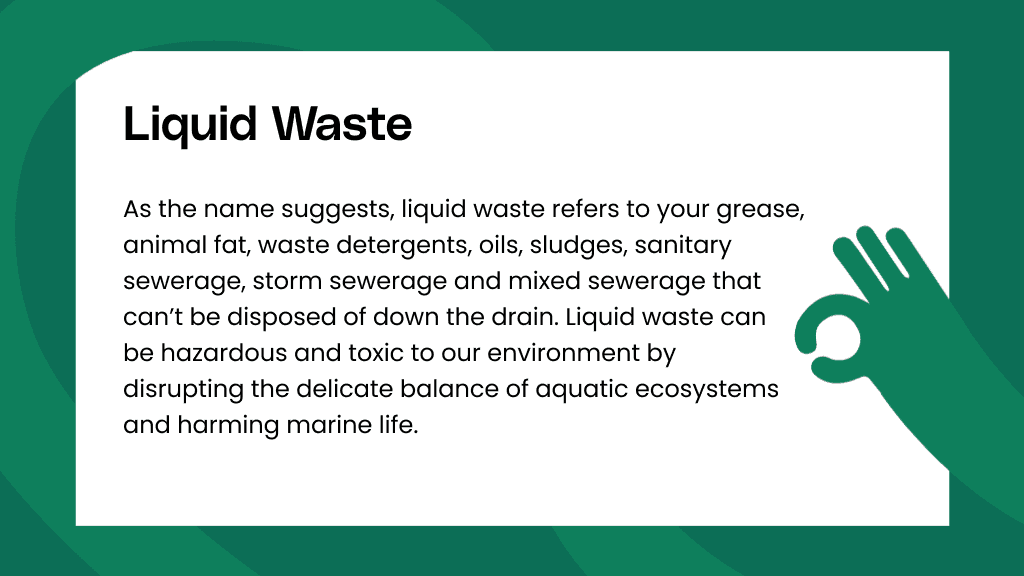All about Reclaim Waste
All about Reclaim Waste
Blog Article
Getting The Reclaim Waste To Work
Table of ContentsReclaim Waste Things To Know Before You BuyHow Reclaim Waste can Save You Time, Stress, and Money.The 5-Minute Rule for Reclaim WasteReclaim Waste for BeginnersThe smart Trick of Reclaim Waste That Nobody is Discussing
Check out the types, events, and types of fluid waste. Domestic sewage waste describes the waste and items from a domestic septic storage tank. This sort of waste is developed by humans in houses, institutions, and other buildings. This only includes septic storage tanks that have a drain field. The appropriate monitoring and disposal of residential sewage waste need liquid waste to be moved to a sewer therapy plant where the appropriate approaches and equipment are related to cleanse and deal with waste.
Business waste commonly includes potential threats, such as combustible products or a mixture of fluid and strong waste items, and calls for a more sophisticated and comprehensive disposal procedure. The disposal of industrial waste normally includes the purification of waste before transportation to make sure secure and correct disposal. Hazardous waste is produced from byproducts and overflow of commercial processes and production.
This sort of waste can not utilize the very same sewage monitoring transport or procedures as septic or commercial liquids. The commercial waste administration process requires the assessment and testing of liquid waste before it undertakes the disposal process (liquid waste removal). Runoff waste is the fluid waste that comes from overflow and excess stormwater in extremely booming locations or cities
Runoff waste can create contamination and flooding if not handled properly. Guaranteeing appropriate waste monitoring can protect against catastrophes and reduce ecological injury.
The 25-Second Trick For Reclaim Waste
Get in touch with PROS Services today to find out about our waste administration and disposal services and the correct means to take care of the liquid waste you generate.
(https://www.openstreetmap.org/user/reclaimwaste1)This supposed 'wastewater' is not only a vital source yet, after therapy, will certainly be launched to our land, waterways or the sea. Utilized water from toilets, showers, baths, cooking area sinks, washings and commercial processes is known as wastewater.

water used to cool down equipment or tidy plant and tools). Stormwater, a type of wastewater, is overflow that moves from agricultural and city areas such as roofing systems, parks, yards, roadways, courses and seamless gutters right into stormwater drains, after rain. Stormwater moves untreated straight to regional creeks or rivers, ultimately reaching the ocean.
All About Reclaim Waste
In Queensland, most wastewater is treated at sewer therapy plants. Wastewater is moved from residential or industrial sites through a system of drains and pump terminals, called sewerage reticulation, to a sewer treatment plant. Regional federal governments develop, preserve and run most sewage therapy plants. Operators are accredited under the Environmental Protection Act 1994 to release cured wastewater at an acceptable environmental standard into rivers.
The Division of Natural Resources recommends regional governments concerning handling, operating and maintaining sewerage systems and treatment plants. In unsewered locations, city governments may require homeowners to mount individual or home sewer treatment systems to deal with domestic wastewater from toilets, cooking areas, restrooms and washings. The Department of Natural Resources authorises the usage of home systems when they are proven to be efficient.
Most stormwater gets no treatment. In some brand-new subdivisions, therapy of some stormwater to eliminate litter, sand and crushed rock has started making use of gross toxin traps. Wastewater therapy happens in 4 stages: Removes solid matter. Bigger solids, such as plastics and various other items mistakenly released to drains, are eliminated when wastewater is travelled through displays.
Uses little living organisms recognizes as micro-organisms to break down and get rid of staying liquified wastes and fine particles. Micro-organisms and wastes are included in the sludge.
The Best Guide To Reclaim Waste
Nutrient elimination is not offered in any way sewer therapy plants due to the fact that it requires expensive specialized devices. It is ending up being more common in Queensland. Clear liquid effluent created after therapy might still contain disease-causing micro-organisms. If this effluent is released right into waterways such as rivers or the sea, the micro-organisms will ultimately die out.

This usually suggests wastewater needs to be dealt with or pollutants removed prior to it can be discharged to waterways. The majority of wastewater streams into the sewerage system. Under the Act, neighborhood federal governments carry out approvals and licences for ecologically pertinent activities (ERAs) entailing wastewater launches that may have a neighborhood influence. The division carries out authorizations and licences to Ages involving wastewater releases that might have a regional or statewide effect.
The smart Trick of Reclaim Waste That Nobody is Discussing
Surveillance gives accurate info regarding water high quality and can verify that permit conditions are being satisfied. The information gotten through surveillance supplies the basis for making water quality choices.
Report this page